
- The intellectual heart of the campus beats strongly…
- The Bridge to McHenry
- A Saga of Persistence: The New McHenry Library
- Back to Basics: Teaching Students What to Look for, and How
- Our 21st Century Learning Environment
- Dead Central, a Gift of the Brittingham Family Foundation, Set to Open
- An Eye to the Future
- A Fond Farewell
The intellectual heart of the campus beats strongly…
The new McHenry Library is hugely popular with students, faculty, and staff
 By Ginny Steel, University Librarian
By Ginny Steel, University Librarian
Founding Chancellor Dean McHenry referred to the library as the "intellectual heart" of the campus—a place for learning as well as a place for interaction among the growing numbers of students, faculty, and staff. His vision was realized when McHenry opened in the mid-1960s, but as the decades passed, the centrality of McHenry faded as the building wore out. How wonderful it is now to see McHenry restored to its prime place on campus. The building is a huge hit, and we can now say that McHenry is indeed the intellectual heart of the campus once again.
The construction project didn't happen overnight. Ground was broken in fall 2005, and work on the addition continued through early 2008. A complete renovation effort on the existing building began in 2008 and wasn't finished until summer 2011. Throughout the entire 7 years the library has been fortunate to have benefitted from the hard work, patience, and good humor of the staff. We have also relied heavily on our generous donors for financial and moral support, and their words of encouragement really helped. So many people have contributed so much to this project—it is absolutely true that "it takes a village" to raise a library. Thank you, one and all, for all your support and good wishes!
By Stanley Stevens, Librarian Emeritus
At lunchtime during the summer of 1966, some of us would park ourselves on the hillside next to Central Services Building (now Hahn Student Services) to watch the "bridge to home" take shape.
The bridge builder, balancing himself on the top beam, did his catwalk every day for a month or more as we waited, and waited, for the grand opening of our new home-now McHenry Library.
There weren't many of us on the library staff then, but we all had the same sense of anticipation-anxious to get into a building that was actually designed as a library, one that would be home for the long haul.
On the day when we were finally allowed into the new building, we walked across the bridge, we saw the majestic redwoods in front of the library, the stately cement columns, and the beautiful interior courtyard (now named the Donald T. Clark Courtyard).
The late Don Clark, Founding University Librarian, said in his oral history: 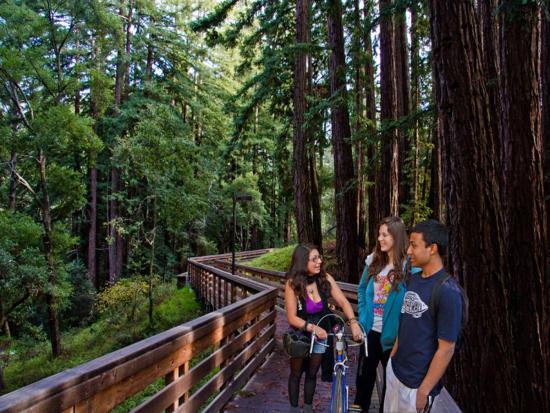
"There are two things that I'm really proud of. One was the staff I built up and the other is the building. . . . Another of my objectives was to make people have pride not only in the job, but pride in the building. . . .
"The external form of the building was created by John Carl Warnecke from the first day he ever saw the site. . . . You'll find sketches, very preliminary sketches of just the outside. I had a feeling that Warnecke wanted to create a Parthenon in the forest. And he did. But it turned out to be a pretty good Parthenon in a sense. . . .
"We had to have a building that would grow as the faculty and student population increased. We were not allowed to plan a building three years beyond the opening date. That is, we could anticipate the size of the campus and the book collection and the staff three years from the opening date, and that was all the state would allow us to do.
"What saved an awful lot of grief was that UC President Clark Kerrhad come up with the notion of the New Campus Program, which was a stroke of genius. The New Campus Program joined the efforts of the San Diego, Irvine, and Santa Cruz campuses in developing a core collection for undergraduates, for college libraries. The Program would do two things. The head of the New Campus Program and the staff would build a bibliography, a selected list of, it turned out to be 50,000 titles and 75,000 volumes. . . . Not only would they develop this list, but they would procure the books. They would go out and buy them for the three campuses, simultaneously. They would catalog them; they would house them. This was all done from 1962 until 1965 when the campus opened."
Clark's hope, that we would "have pride not only in the job, but pride in the building," is as much true today as it was when we crossed that bridge in 1966.
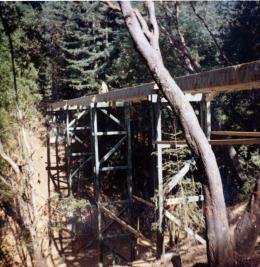 Some of the early library staff included:
Some of the early library staff included:
Donald T. Clark, University Librarian
Wendell W. Simons, Assistant University Librarian
Aileen Sanders, Administrative Secretary
Carl J. Wensrich, Head of Reader Services
Richard Moore, Acquisitions Librarian
C. H. Lowe, Head of Cataloging
Rolf Augustine, Cataloger
Albert Eickoff, Reference Librarian
Margaret Hermann, Reference Librarian
Elizabeth Calciano, Regional History Editor
Rita Berner Bottoms, Head of Special Collections
Martha Bensusan, Head of Circulation
Elise Hoffman, Head of Lick Observatory Collection
Joan Hodgson, Head of Interlibrary Loan
Brad Posey, Principal Clerk-Receiving-Building Manager
Stanley Stevens, Head of Map Collection
A Saga of Persistence: The New McHenry Library
By Robert White, Assistant University Librarian (1980-2006)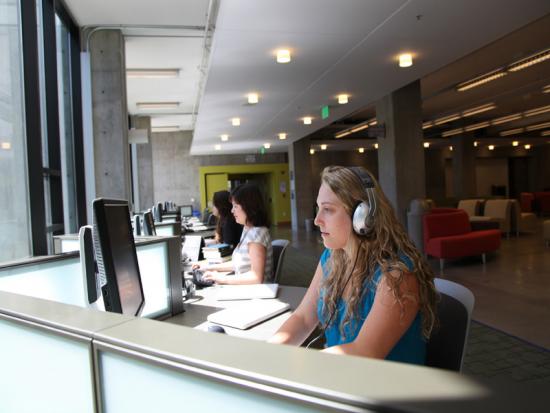 It all began back in 1993, when the lack of space at McHenry Library on the one hand and campus growth projections on the other made it very clear that something had to be done to ensure enough seating for students and shelf space for books.
It all began back in 1993, when the lack of space at McHenry Library on the one hand and campus growth projections on the other made it very clear that something had to be done to ensure enough seating for students and shelf space for books.
Shortly thereafter, BOORA Architects of Portland, Oregon, was selected to plan an addition and renovation to the existing John Warnecke-designed university library building.
In the course of the following two years a plan was devised and construction was expected to begin shortly. However—why does this sound so familiar?—a budget crisis intervened and the project was put on hold indefinitely. Almost a decade later the project was revisited and revised and, thanks to the support of then Chancellor M.R.C. Greenwood and relentless effort by University Librarian Allan Dyson, funding for the McHenry Library Addition & Renovation Project was finally secured in 2003.
Teams of people went to work to plan to plan the long-awaited new library space. BOORA Architects, in association with the McHenry Library Addition & Renovation Building Committee, worked on the multiple phases of the project. Campus Capital Planning Director Fran Owens and her successor Robin Draper were instrumental and tireless in preparing and submitting planning documents for approval by UC Capital Planning.
Complex challenges including much higher building costs than anticipated faced the planners. Incredibly, Campus Architect Frank Zwart and his team navigated and managed this difficult process and moved the project forward without ever forgetting how important it was to preserve the functional, architectural, and aesthetic features of the new library.
In December 2008, due to—yes, you guessed it—another budget crisis, all UC building projects were put on hold. At that point the original library building was a hollowed-out shell undergoing seismic retrofitting. Chancellor George Blumenthal made an appeal and convinced the UC Regents that leaving the building in its current state could, in the event of an earthquake, turn out to be truly costly; they granted an exception and lifted the construction moratorium for the McHenry Library project.
We thought we had weathered the worst, but the ultimate library nightmare was still to come. On April 15, 2010, a fire broke out in the section of the library that was under renovation. A wire in a small construction appliance had smoldered and caught fire. The good news within the bad news was that the library collection had been moved to the new wing of the library and so did not go up in the flames. The fire was quickly controlled but massive amounts of soot and smoke meant that the entire library, including every single book on the library addition shelves, all air vents and heat ducts, etc., had to be cleaned.
The Library's Administration and Staff persevered through all of the above, first under the indefatigable leadership of Allan Dyson, and, since 2005, under the ever-positive leadership of University Librarian Ginny Steel. All construction was completed and both wings of the library reopened for use at the beginning of Fall Quarter 2011. Today we all share in the pride of the finished product—a 21st-century academic library and state-of-the-art research facility that can deliver on the instructional and research needs of UCSC students and faculty.
It is nothing short of a miracle that the venerable McHenry Library, named after Founding Chancellor Dean McHenry, has been preserved with its elegant visual and architectural features and is now back as the intellectual heart of the campus. Let us celebrate this accomplishment!
Back to Basics: Teaching Students What to Look for, and How
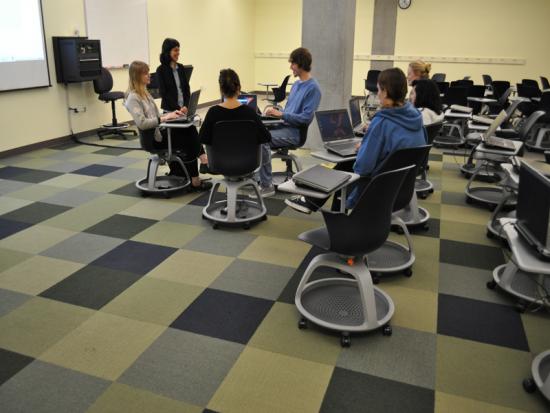
By Ezra Berger
It's winter quarter of your freshman year and you've just been assigned the first big research paper of your college career.
You can't help but feel a little bit nervous. Sure, you wrote a couple of eight-page essays in your senior year of high school, but most of your citations were either Wikipedia pages or something along the lines of "Hamlet says it on page 62." You definitely never consulted any of these "peer-reviewed journals" your professor keeps mentioning.
A journal? Isn't that what you used to call the little leather notebook where you meticulously recorded your 7th-grade crush of the week? You stiffen. That journal wasn't "peer reviewed," was it?!
And come to think of it, where would you even find one of these "journals?" Well, it turns out that journals today are almost all in databases. While you imagine those databases probably have something somewhere that's related to your paper on the occurrence of rhetorical dissonance in the municipal elections of late-19th-century West Virginia, it occurs to you that it might not be the easiest thing in the world to track down . . .
Enter our fearless protagonist, the teaching librarian!
See, it turns out that newly arrived college students have had difficulty locating and properly citing sources since, well, always. And as the campus institution that houses and locates said sources of arcane knowledge, the library took note of this undergraduate phenomenon and decided to offer some much-needed assistance.
The remedy? Partnerships with faculty to tailor library instruction to match assignments. Conducted in a new, state-of-the-art instruction room on McHenry's second floor, most library instruction classes are coordinated with introductory writing classes. The aim is to make students "research-literate" at the college level.
"Because of tools like Google, students are already fluent with the technology," says Annette Marines, a teaching librarian, in reference to the various online databases that 21st-century undergraduates use for their research. The goal, she says, is not to teach students how to simply use these databases—today's freshmen are almost universally familiar with interfaces and notion of "searching"—but rather how to use them effectively.
Teaching librarians help students learn how to frame questions that will yield relevant and manageable search results. Students learn how to find reliable background material and then apply what they've learned to the current assignment. The result is information-literate students.
The instruction room's interactive environment was significantly enhanced this past year by the replacement of standard desks with 50 "node chairs." Vaguely reminiscent of flying saucers, these Information-Age workstations are comfortable wheeled desks designed specifically to be used with laptops. The desks' wheels make it easy for students to switch between facing the front of the classroom and engaging with their peers in small groups.
This year the library instruction program, which includes writing classes, will educate a total of nearly 3,800 freshmen. In addition, teaching librarians and archivists will provide approximately 1,200 upper-division UCSC students with discipline-specific research instruction.
And just in case you find that good old collegiate skepticism sneaking into your thoughts as you read this, you should know that professors consistently report to Marines that they receive better papers, more questions in class, and better overall student engagement from information-literate undergraduates.
And so, to all you frantic and overwhelmed freshman Banana Slugs, don't panic! Take a deep breath, close that Wikipedia page and pull up a node chair; the teaching librarians are going to take good care of you!
Our 21st-Century Learning Environment
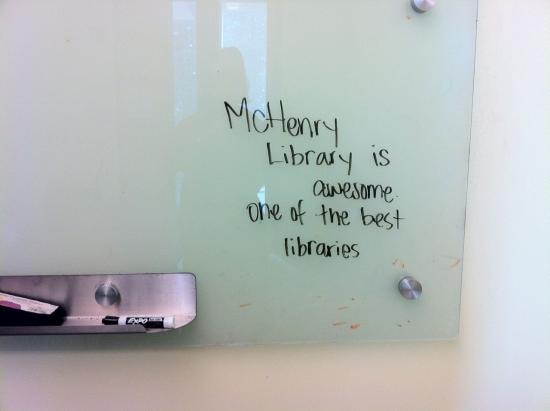
By Ezra Berger
The needs of today's students for collaborative study spaces, electricity, Internet connectivity, and technology are vastly different that were those of students in 1966 when the original McHenry opened. From the basement to the fourth floor, the study spaces at the new McHenry meet the needs of today's UCSC students.
Greg Careaga, who is the University Library's Head of Research, Outreach and Instruction, was responsible for designing the new layout of the library's study areas. According to Careaga, his goal was to create more overall study space and to ensure flexibility in the learning environment. To that end, McHenry now offers nearly 40 group study rooms, 150+ computer workstations, diner-style booths, "laptop bars," and a wide variety of quiet reading areas.
To provide spaces conducive to both quiet and "social" learning, Careaga drew upon research he conducted during a 2009 trip to university libraries in the Pacific Northwest, as well as student surveys and ideas from industry publications. The result is a carefully designed floor plan that uses furniture and "geography" to distinguish between study areas of differing ambience.
Careaga and the library also devoted copious resources to facilitating group study, furnishing a vast suite of specialized group study rooms throughout the library, many of which are equipped with truly awesome, specialized high-tech equipment to meet specific needs. [See sidebar] [Sidebar will appear in all formats of the newsletter]
"People are more productive when they have room to spread out," he explains, "and research shows that students are conditioned to be less active learners in rank and file geometric configurations." The new, 120-degree workstations are more conducive to active thinking and they provide a generous amount of space for students to lay out textbooks, notebooks and other materials, including coffee and snacks.
As the primary academic resource center for UCSC, it is essential for McHenry to house facilities that can accommodate the broad scope of activities that take placeat a major 21st-century research university. Thanks to the renovation, the library is now more prepared than ever to meet these varied educational needs.
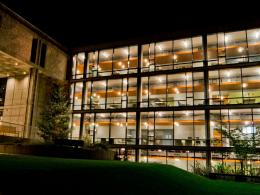 An online booking system makes it easy for students to reserve these and the other group study rooms at the University Library:
An online booking system makes it easy for students to reserve these and the other group study rooms at the University Library:
- Presentation Practice Room: Equipped with a video camera and 42" flat screen TV (for recording and watching oneself perform), an adjustable-height lectern with laptop connection, and a glass "whiteboard," the room is ideal for students who want to fine tune in-class or other presentations with a practice run.
- Eight Video Viewing Rooms: Accommodating a range of occupancies (from ten to twenty students), these ground floor rooms are theater-like spaces equipped with wheeled cushy chairs, surround sound, and 59" HDMI TV screens. Ideal for both educational and recreational movie watching.
- Seven Music Listening Rooms: Meant for solo or small-group listening sessions, many of these rooms include an AppleTV that can play music directly from the library's reserves, as well as a CD player. Two "traditional" listening rooms trade out the AppleTV in exchange for a cassette player and phonograph.
- Keyboard Practice Room: This room houses a MIDI (Musical Instrument Digital Interface) keyboard and a connected computer and is ideal for music composition and practice.
- Beverly & Charles Levine Adaptive Technology Room: This room was built to accommodate students with disabilities such as limited sight or hearing. It includes a computer with text-to-speech capability, a scanner, and magnifying station for easy viewing of documents.
Dead Central, a Gift of the Brittingham Family Foundation, Set to Open
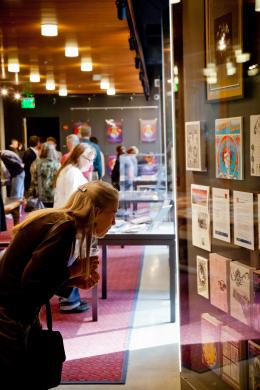 By Nicholas Meriwether, Grateful Dead Archivist
By Nicholas Meriwether, Grateful Dead Archivist
Scholars and fans rejoiced when they heard the news that the Grateful Dead had decided to donate their voluminous archive to McHenry Library at UC Santa Cruz in April 2008. While the band had already been the focus of a great deal of academic attention, none of it had been based on the materials in the band's archive—and the success of that early work portended even greater insights for scholars who had access to those files.
Since the donation of the band's archive, a team of people at McHenry Library has worked to process, digitize, and exhibit those materials, all with an eye toward making those treasures accessible to researchers and the community. This spring, Dead Central opens to the public, with our first exhibit, "A Box of Rain: Archiving the Grateful Dead Phenomenon," showcasing the treasures of the Archive. This summer our online portal will launch, providing anyone with an internet connection a way to access digital versions of many of the archive's materials.
Already a number of scholars and writers have contacted the Archive to arrange for access to the materials they need to complete their research. Historians, musicologists, communication theorists, sociologists, and media specialists are all working on projects that draw on the Archive's materials, and scholars from more than a dozen other fields have expressed interest in working with the Archive.
It makes this a heady time for archivists and cultural historians interested in the sixties, the counterculture, and all of the related contexts that inform the Grateful Dead phenomenon. Although work on the archive will continue for years to come, as this marquee collection becomes available, researchers will at last be able to ground their work and insights in what is one of most remarkable and compelling archives documenting a major American cultural movement hosted by a major academic institution today.
By Ezra Berger
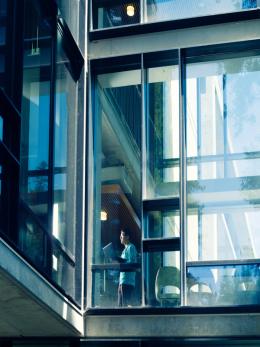
The completion of the McHenry building project marks a proud and historic milestone for UCSC and the University Library. But needs keep evolving, and as the Library looks to the future the possibilities for further improvement and expansion of services are many and varied. Thus, with the overarching goal of enhancing the transformative educational experience that alumni and current students share, the Library has identified a new set of priorities for the coming years.
Science and Engineering Library Renovation
While easily one of the campus' most beautiful buildings, the Science & Engineering Library (S&E) needs a few updates to be able to serve the changing needs of students. In the next few years, these improvements are planned:
Create an Information Commons like the one at McHenry Library. This will bring S&E's information infrastructure up to speed with the digital age.
- Expand hours to create a late-night study area for students. While both libraries currently offer long open hours, our students always need more.
- Create a Geographic Information Systems Center that will supply innovative tools to support real-time data collection and comparison for field researchers in all disciplines.
- Expand and renovate the Video Gaming Lab. With a new major in Computer Gaming and a hugely built-out Digital Arts Department, UCSC is a leader in synergies between the arts and computer science.
Digital Asset Management
Broadly conceived, the mission of the University Library is the management of the campus' "intellectual assets." Every year UCSC researchers write scholarly papers, amass data sets, and create the knowledge that fuels inventions and enriches our lives. Leveraging statewide expertise in the UC system, the Library has a plan to provide resources for preserving, curating, and making accessible all the research data and scholarly works created by UCSC faculty. The service, known as Digital Asset Management, will require powerful storage systems and highly sophisticated software, as well as skilled archivists and information-technology professionals.
Digitization of Special Collections
One of the Library's primary objectives is to streamline the process of finding and using the information contained in its collections. By digitizing a collection, the library can make its contents readily available to users wherever those users may be. It's a process that begins with extremely high-resolution photography or scanning of physical items, and is completed by fully describing and cataloging each item so it can be easily found.
UCSC Special Collections is proudly undertaking a long-term project to digitize many of its holdings, which include collections such as the Grateful Dead Archive, the University Archive that documents campus history, archives pertaining to local history like that of the influential Hihn family, and some of the over 500,000 photographs by artists such as Ansel Adams, Wynn Bullock, Edward Weston, and Pirkle Jones.
Are libraries relevant today? The answer is a resounding "Yes!"
 Dear Supporters and Friends of the UCSC Library,
Dear Supporters and Friends of the UCSC Library,
With one laughing and one weeping eye I am writing to you today to let you know that I am returning to my home country Germany and that my time at UCSC has come to a close.
It has been a great privilege to serve you all, an amazing experience to listen to your stories, thoughtful advice and high hopes for the UCSC Library.
We also shared some adventures in between. Such as the advent of the Grateful Dead Archive, library exhibits in New York City and in Cleveland, meeting the $3.5 million Kresge challenge, winning a John Cotton Dana Award, and last but absolutely not least the completion of our wonderful McHenry Library and the big celebration last month when after almost two decades of planning and six years of construction we finally rededicated it and put it back to service.
None of this would have happened without you!
As I am leaving the US I am taking with me fond memories and warm thoughts-thank you!
Astrid von Soosten, CFRE
Senior Director of Library Development
Editor: Lettie Bennett
Contributors: Ginny Steel, Stanley D. Stevens, Robert White, Ezra Berger
Design and Art Direction: Jim Mackenzie
Production: Linda Hunt, Vanessa Stevens
Copyediting and Proofreading: Mark Engel


 Santa Cruz, CA
Santa Cruz, CA



